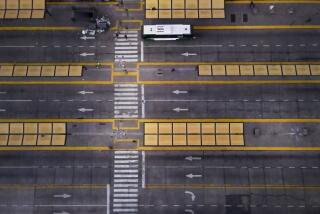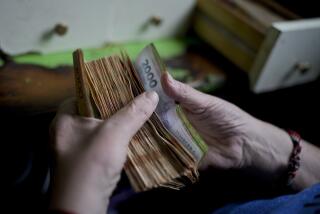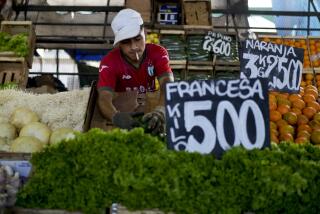Floating Argentine Peso Declines by About 40%
- Share via
BUENOS AIRES — Showing little confidence in their country’s economic future, Argentines drove down the value of their national currency, the peso, as it floated on the open market for the first time Friday after a decade when it was worth a dollar.
The peso traded at about 1.7 to the dollar at Buenos Aires exchange houses and banks, which reopened to currency trading following a three-week “partial banking holiday” imposed by a government trying to stem the flight of capital from the recession-ravaged country.
Long lines formed outside exchange houses Friday as desperate Argentines sought to get their hands on greenbacks. By the end of the day, the peso had lost about 40% of its former value.
“I feel awful, like everyone,” said David Esequiel, a schoolteacher who needed to buy dollars for a vacation in Mexico. “I have very little hope for the future. Rates will rise. Many people are speculating.”
The administration of new President Eduardo Duhalde set the exchange rate of the peso for government transactions at 1.4 to the dollar earlier this month but also said it would allow the currency to float on the market. At one point Friday, some exchange houses here were selling dollars for 1.8 pesos, although the peso firmed slightly during the afternoon.
The return of currency trading came amid a climate of tension throughout this capital. Late Thursday and early Friday, thousands of people took to the streets, beating pots and pans, to protest the government’s decision Thursday to freeze bank accounts.
A number of downtown banks were looted and burned early Friday as the peaceful protests turned violent. Four people were arrested.
“The outrage of the Argentine people is total,” said Juan Appes, a merchant seaman waiting to exchange dollars for pesos so he could pay bills. “There will be more looting, more deaths. This is nothing more than a banana republic.”
At least 27 people died in protests and rioting last month when tens of thousands of people took to the streets and drove Argentina’s president, Fernando de la Rua, from office.
De la Rua imposed the banking holiday and placed limits on bank withdrawals after depositors had withdrawn nearly $15 billion--about 20% of the money in the banking system--since the beginning of April.
Duhalde took office Jan. 2. His spokesman said Friday that the government shares “the pain, the anger and the need” of the most recent protesters.
“It is likely we will have more of these episodes,” spokesman Eduardo Amadeo said. “One day it will be 5,000 people protesting; another day, 300.”
In 1991, the administration of President Carlos Menem tied the value of the peso to the dollar. Observing a strict monetary policy, the government printed pesos in a quantity equivalent only to the number of dollars it held in reserve.
The dollar peg began to crumble late last year as a fourth year of recession increased the budget deficit and sent the nation’s public debt soaring to $135 billion.
Fears of devaluation had already led many businesses to raise the prices of many goods this week, including basic foodstuffs such as bread and sugar.
More to Read
Sign up for Essential California
The most important California stories and recommendations in your inbox every morning.
You may occasionally receive promotional content from the Los Angeles Times.











